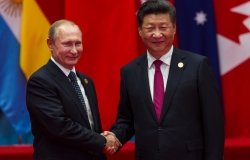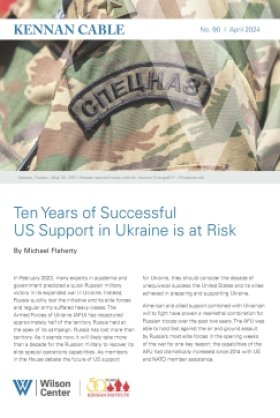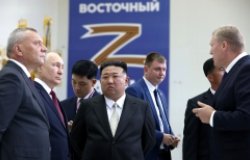Encountering the Global Economy after Communism: Russia and China Compared
China "has embraced the international economy with two hands," remarked Harley Balzer, Associate Professor, Department of Government and School of Foreign Service, Georgetown University at a 17 October 2005 Kennan Institute seminar. "Russia has an open economy, but its international integration is thin." Balzer argued that over time China's economic policies have been strongly influenced by coalitions of entrepreneurs, government officials, and investors, while in Russia policy has increasingly been dominated by the central government.
According to Balzer, the biggest global change during the past twenty years was not the end of Communism, but rather the impact of China and Russia on the international economy. In the late 1970s, modernization theory suggested that Russia was better positioned for industrial development: universal literacy, newspaper saturation, large numbers of educated professionals, and a large R&D community were seen as indicators that Russia would be an industrial power in the 21st century. China was an overwhelmingly peasant society just emerging from the Cultural Revolution. During the following thirty years, economic and political changes confounded this prediction. Balzer noted that China's GDP has grown much more rapidly over the past 15 years than has Russia's, and that China has caught up with Russia on many important development indicators. He attributed China's greater economic success to its "thicker" integration with the international economy.
Balzer compared the attitudes of Russian and Chinese elites as one important factor in their different approaches to the global economy. Russia began its reforms as a co-equal superpower, and many in Russia view globalization as Western or American infiltration. China began its reforms following the Cultural Revolution with a political elite less invested in the old system. Approaching globalization with a "nothing to lose" attitude and a realization that there could be much to gain aided the leadership's decision to promote integration with the world economy.
Balzer continued by comparing Russia's and China's initial steps toward international integration. Following the collapse of the USSR, the Russian government initiated an extensive reform process that greatly increased the country's political and economic openness. However, Russia's economy has come to rely heavily on exporting natural resources. Balzer argued that the Chinese government has not developed a better industrial policy than Russia, but rather has "lost control" in certain key regions and sectors, allowing them to become thickly integrated with the global economy. He emphasized that "success in the global economy depends not on a country's degree of openness but on the quality of its integration."
Balzer cited four areas that demonstrate China's thicker international integration and Russia's ambivalence. First, China has been more open to internationalizing science and education. Although China and Russia currently devote equal proportions of their GDP to education, China is no longer suffering as much from "brain drain." Specialized programs in China promote educational, scientific, and technological development, such as special housing and research funding offered by the Chinese government to qualified Chinese scientists who return from abroad. Secondly, Balzer argued that China's policies produced intense competition among its regions for FDI and international linkages. Chinese regions competed to host special economic zones and put pressure on the central government to expand the zones and open them further to international integration. By contrast, Russia's special economic zones became ways to circumvent taxes rather than fostering production.
A third reason for China's success involves the leading sectors in the two economies. Balzer pointed out that "finished goods represent only 9 percent of Russian exports to China, while they constitute 90 percent of Chinese exports to Russia." Dependence on exporting raw materials narrows Russia's opportunities for economic integration, while China has evolved into a global producer of manufactured goods and is increasingly moving up technology chains in a variety of industries. Fourth, Balzer noted that while corruption rankings indicate that it is an enormous problem in both countries, corruption seems, at least thus far, to be doing less damage in China. The difference, he argued, is in the nature and quality of the corruption. Russia's natural resource economy leads to rent-seeking, unproductive corruption, while corruption in China occurs in conjunction with real investment in industry and infrastructure.
According to Balzer, the common argument that China succeeded with gradual market reforms while Russia failed due to excessively rapid reforms misses the key point. China is not an example of effective state-led reform, because its greatest successes are in areas where the state has largely lost control and been forced to accommodate development coalitions and international market forces. In large part, China's leaders "are taking credit for simply getting out of the way." However, "when Russian commentators suggest that they need to emulate China's policies, they generally have in mind policies based on strong governmental controls, rather than the diverse and often highly independent local and regional economic activity linked to the international economy that accounts for China's success," he concluded.
About the Author

Kennan Institute
The Kennan Institute is the premier US center for advanced research on Russia and Eurasia and the oldest and largest regional program at the Woodrow Wilson International Center for Scholars. The Kennan Institute is committed to improving American understanding of Russia, Ukraine, Central Asia, the Caucasus, and the surrounding region though research and exchange. Read more










